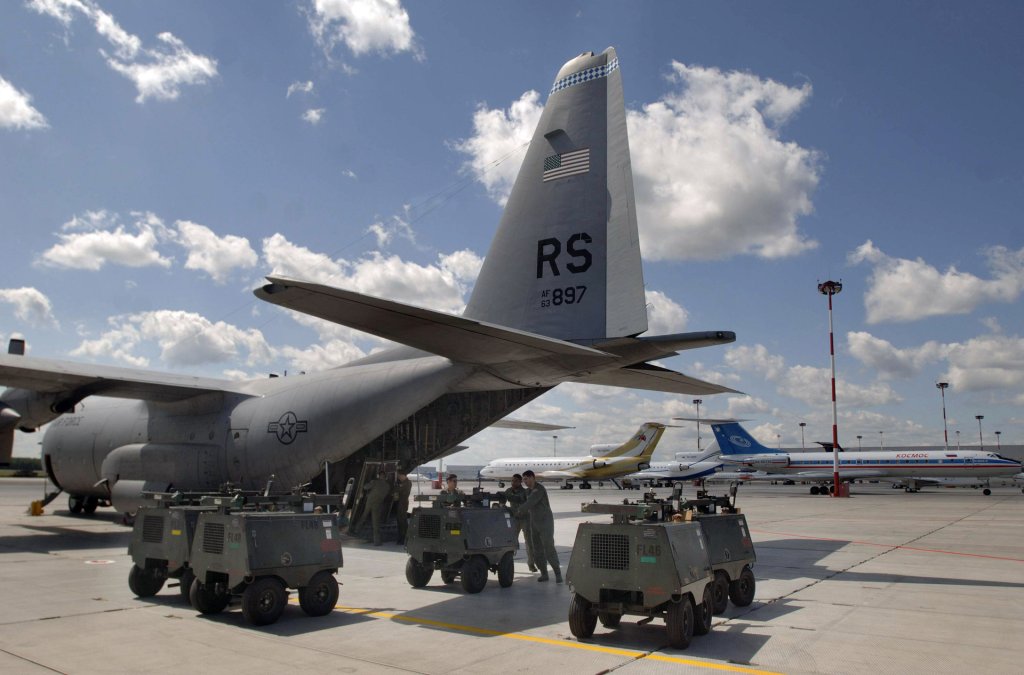The Ukrainian Air Force has received a fleet of new vehicles to help it operate and maintain its Western-supplied F-16 Viper fighters at dispersed locations around the country. This underscores the challenges Ukraine faces in generating air combat power under the constant threat of Russian attacks. Ukraine’s experiences in this regard are already deeply influencing the U.S. military, which is planning to operate crewed and uncrewed aircraft from distributed forward locations in future high-end fights, such as one against China in the Pacific. These concepts of operations would also be relevant in the event of a major conflict elsewhere in Europe.
Come Back Alive, a charitable foundation in Ukraine, announced the delivery of two sets of vehicles primarily intended to help with munitions handling and maintenance of F-16s, as well as a mobile command post to support mission planning tasks, yesterday. Come Back Alive worked together on the project with Office 61, a component of Ukraine’s state-run defense industrial complex, and state-owned oil and natural gas company Ukrnafta. At least 85 F-16s have been pledged to Ukraine from multiple countries, but how many have been delivered is unclear. The Ukrainian Air Force has also lost at least four of the Vipers it has received.
Each of the munitions handling and maintenance vehicle sets consists of one 4×4 workshop truck, designed in part to help with the “preparation and testing of aviation weapons,” as well as two more 4×4 trucks equipped with small cranes that are able to aid in “attaching munitions to the aircraft,” according to Come Back Alive. A 4×4 pickup is also provided, primarily to help carry additional personnel. The 4×4 trucks look to be based on members of the Daily family produced by Iveco in Italy. The pickups appear to be from Peugeot in France.



What Come Back Alive calls the “Mission Planning Complex” consists of a German-made 6×6 MAN truck and a 4×4 trailer. The truck has workstations for up to seven individuals to support mission planning and related tasks. Ukrainian F-16 pilots will also be able to receive pre-mission briefings inside the vehicle. The trailer is described as a “residential module for long-distance relocations,” suggesting that it might be something of a camper van that personnel can at least sleep inside in the absence of more established facilities.

All 10 vehicles collectively cost 51,354,554 Ukrainian hryvnia (UAH), or just over $1.23 million at the rate of conversion at the time of writing, of which 49,438,176 UAH (approximately $1.18 million) came from Ukrnafta, according to Come Back Alive.
“This project became the Foundation’s first focused on working with the F-16. Here we solve two tasks: the first is a mobile mission planning command post; the second is preparation for the use of aviation weapons,” Taras Chmut, Come Back Alive’s Director, said in an English language press release put out yesterday. Ukraine’s F-16s “operate under the conditions of a full-scale war — with constant sorties and continuous Russian hunting for the aircraft. “In conditions of limited time for the full deployment of infrastructure for the F-16, the most rational solution is to invest in a mobile ecosystem. It will allow for the maximum use of the capabilities of the most complex Western equipment already now, during a modern war, where efficiency and speed affect its course.”
“This complex is the implementation of the most urgent needs of Air Force specialists. Taking into account the advanced experience of European countries regarding the use of aviation weapons, particularly the armament of F-16 aircraft,” an unnamed representative from Office 61 also said in a statement in the release. “The need for such a complex arose due to the extensive system of aircraft basing and the lack of specialists. The implementation of this project will significantly increase the Air Force’s ability to destroy the enemy.”
More specifically, “previously, 10 to 12 people were needed to hang one ammunition [onto an F-16]. Thanks to this complex, it is now possible to realize with the help of three people,” a representative from Office 61 identified only as Sergei also said, according to a machine translation of a statement in a separate Ukrainian language press release the vehicle deliveries from the Ukrainian Air Force.
To date, Ukraine’s F-16s have been observed with air-to-air and air-to-ground loadouts that include AIM-120 and AIM-9 air-to-air missiles, as well as GBU-39/B Small Diameter Bomb (SDB) precision-guided glide bombs. Vipers delivered to Ukraine also notably have relatively advanced electronic warfare suites.

All of this highlights the challenges the Ukrainian Air Force continues to face in adapting its existing playbook to its new fleet of second-hand F-16s, issues that could also apply to other Western-supplied aircraft now and in the future. It is worth noting here that Sweden’s Gripen fighter, which has been discussed in the past as a possible option for Ukraine, was designed around distributed operations under wartime conditions.
This is all on top of already extremely demanding wartime conditions that see Ukraine’s combat jets, including older Soviet-designed types built with more austere operating locations in mind, take off and land at different bases as a matter of standard operating procedure to reduce vulnerability to Russian attacks. Ukrainian fighters have also trained in the past to make use of highways as alternatives to traditional runways.
The war between Russia and Ukraine has only underscored how vulnerable modern military aircraft are on the ground, especially if they are parked on open flightlines. Ukrainian forces have themselves targeted Russian air bases with long-range missile and drone attacks, as well as commando raids. In June, the Security Service of Ukraine (SBU) launched an unprecedented covert drone attack operation on multiple Russian air bases from within that country, which destroyed a number of prized strategic bombers and other aircraft.
Expanding the total number of airfields that Ukraine’s F-16s can operate from can only improve the effectiveness of that shell game. The vehicles that Come Back Alive and its partners have now delivered allow for the prepositioning and repositioning of ground support assets to new locations simply by driving there. They could even be on the move from one location to another while Vipers are flying their missions to help maximize their utility.
While the Ukrainian Air Force faces unique challenges with the F-16 after years of flying Soviet-era aircraft with significantly different operational and sustenance requirements, the complexities of generating combat airpower while under attack are more broadly applicable to armed forces globally. The U.S. Air Force and the U.S. Marine Corps, in particular, see the ability to conduct distributed air operations from far-flung locations as key to not just success, but survival in future high-end fights. The Air Force has also been open about drawing lessons learned already from observations of the conflict in Ukraine, which are feeding into still-evolving concepts of operations referred to collectively as Agile Combat Employment (ACE).

“I have the opportunity to talk to the Ukrainian air chief once every two weeks, or so. And they’ve been very successful not getting their aircraft hit on the ground,” Air Force Gen. James Hecker, head of U.S. Air Forces in Europe (USAFE), said during a panel discussion at the Air & Space Forces Association’s Warfare Symposium in March. “And I ask him, I said, ‘How is that? What do you do?’ And he goes, ‘Well, we never take off and land at the same airfield. I’m like, okay, you know, that’s pretty good. Keeps the Russians on their toes.”
“I got tons of airfields from tons of allies, and we have access to all of them. The problem is, I can only protect a few of them,” he continued. “We can’t have that layered [defensive] effect for thousands of airbases. There’s just no way it’s going to happen.”
“So, to go think you’re going to land at another airfield and hang out there for a week with no defense, you’re going to get schwacked. It’s going to happen,” he added. “You can only stay there for a little bit, and then you’ve got to get back to your main operating bases.”
“It’s going to be much shorter operations. You know, we’re not talking weeks anymore,” Hecker explained. “We’re talking days, and sometimes we’re talking hours, if you want to be survivable. And then back at your main operating base, you’ve got the layered defense.”
Hecker further highlighted the demands this then puts on supporting assets on the ground at these dispersed locations.
“So you got to figure out, where do you pre-deploy weapons, which we’ve done amongst a handful of bases right now … equipment, and where’s that going to be,” he said. “And are you just going to stop for a gas-and-go? Go do your mission, and then go back to your main operating base to get weapons?”

The Air Force sees these questions as being further pronounced around the planned introduction of new Collaborative Combat Aircraft (CCA) drones, which the service describes as being its first aircraft designed from the ground up for future distributed operations.
“When you think about the sustainment architectures that we built in the past, the thought was that they were going to be in sanctuary,” Air Force Maj. Gen. Joseph Kunkel said during a talk that the Hudson Institute think tank in Washington, D.C., hosted earlier this year. “So, you know, you could afford to build a piece of aircraft ground equipment that weighed 10,000 pounds and wouldn’t fit on a C-130.”
Kunkel is director of Force Design, Integration, and Wargaming within the office of the deputy chief of staff for Air Force Futures.
“I will tell you, some of it’s not like the sexy, cool stuff. It’s like the basics. It’s like bomb loaders, missile loaders, and, you know, refueling trucks and, you know, electric carts and air conditioning carts,” Kunkel added at that time. “They’ve got to be made differently.”

“So I mentioned earlier that DAO [distributed aviation operations] is really challenging us in the enabler world to kind of evolve our tactics, our formations, and our equipment to really get better, get lighter, [and] get faster,” Marine Col. Mike McCarthy, then head of the office of the Deputy Commandant for Aviation’s aviation enablers branch, had also explained during a presentation at the 2024 Modern Day Marine exposition.
At that time, McCarthy specifically highlighted how this had prompted new Marine requirements for a C-130-transportable airfield crash truck to support future expeditionary and distributed missions. He also discussed work to add new infrared cameras to the service’s existing larger P-19R crash trucks to improve their ability to operate in remote and austere environments, as well as in the aftermath of enemy attacks. This all further underscores the often underappreciated demands of conducting air operations from dispersed locations.

Road-mobile assets will not have the same degree of utility in all locales, especially during any future operations across the broad expanses of the Pacific. At the same time, when it comes to airlifting a support package to a forward location, making it as compact and mobile as possible would still be very important. Cargo aircraft capacity would be in very high demand overall and stretched to its limits in any high-end fight.
Altogether, the delivery of new trucks to the Ukrainian Air Force may seem like a relatively development, but that service clearly sees their arrival as offering an important boost in capability and capacity for generating F-16 sorties. This may well come to reflect a broader trend toward the fielding of lighter and/or more mobile ground assets to support air operations, including in the U.S. military.
Contact the author: joe@twz.com


